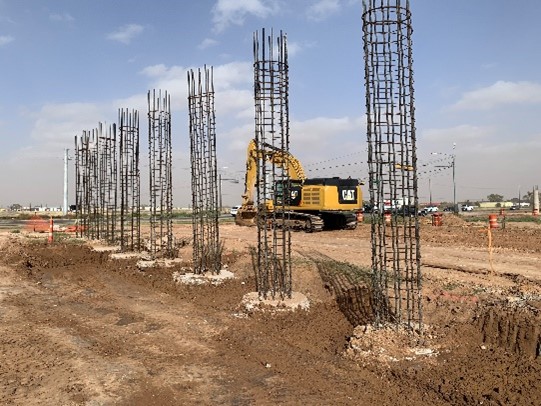Specialized Geotechnical Works for Lasting Building Solutions
Specialized Geotechnical Works for Lasting Building Solutions
Blog Article
Checking Out the Necessary Duty of Consulting Engineers in Geotechnical Projects: An Extensive Overview of Their Payments and Duties
Consulting designers work as critical figures within geotechnical projects, tasked with the complex obligations of analyzing subsurface problems and guaranteeing the architectural honesty of building and constructions. Their know-how not only shapes design parameters and regulatory conformity but also helps with crucial interaction amongst different stakeholders, thereby enhancing job results. The intricacy of their duty is more underscored by the need for proactive threat monitoring approaches and ecological considerations. As we explore the multifaceted payments of seeking advice from designers, it comes to be evident that their involvement is vital to navigating the challenges intrinsic in geotechnical ventures. What details approaches do these professionals utilize to secure job success?
Introduction of Geotechnical Design
Geotechnical design is a vital technique within civil design that focuses on the actions of planet products and their communication with frameworks. This area incorporates the study of soil, rock, groundwater, and the technicians controling their residential properties and actions. Geotechnical engineers analyze the physical and chemical buildings of these materials to identify their suitability for different building projects, making certain that structures are started on stable and reliable ground.

Moreover, geotechnical designers need to consider ecological aspects, such as soil contamination and groundwater monitoring, to advertise lasting development. Their proficiency is important in optimizing the layout and building procedures, eventually adding to the longevity and security of civil engineering jobs.
Secret Duties of Consulting Engineers

In addition, they are accountable for establishing layout parameters and specifications that stick to regulatory requirements and finest techniques. This includes evaluating site problems and establishing appropriate building and construction approaches, which is vital for reducing dangers associated with ground instability.
Consulting engineers additionally work as liaisons between different stakeholders, including clients, professionals, and regulative bodies, helping with clear communication and cooperation throughout the job lifecycle. consulting civil engineering companies. They provide experienced support during construction, guaranteeing that geotechnical aspects are adequately addressed and that any type of unexpected obstacles are handled properly. Eventually, the diverse responsibilities of speaking with engineers are fundamental to the honesty and success of geotechnical jobs, influencing both safety and sustainability in building practices
Website Evaluations and Examinations
An extensive site assessment is important for comprehending the subsurface conditions that influence geotechnical projects. Consulting engineers play an essential role in carrying go right here out these analyses to make certain the safety and viability of building activities. This process usually entails a series of investigations, including dirt sampling, borehole boring, and geophysical surveys, to gather essential data on dirt residential properties, groundwater degrees, and the geological context of the website.
Engineers examine the obtained information to identify the possible difficulties positioned by the subsurface problems, such as soil instability or high groundwater levels, which can influence the design and execution of the task. In addition, website analyses aid in reviewing the visibility of pollutants, which is essential for environmental compliance and making sure public safety.
In addition, speaking with designers coordinate with multidisciplinary groups to integrate searchings for from site examinations right into more comprehensive project goals. Via strenuous paperwork and coverage, they offer vital understandings that notify stakeholders concerning the suitability of the website for recommended developments. Eventually, the thoroughness of site analyses lays the foundation for efficient planning and engineering options, mitigating threats connected with unpredicted subsurface conditions.
Style and Danger Management
After carrying out thorough site analyses, speaking with engineers focus on the layout and risk monitoring aspects of geotechnical tasks. This phase is important as it makes sure that the crafted solutions are not only reliable however also safe and sustainable (consulting civil engineering companies). Engineers utilize their know-how to establish layouts that resolve the specific geotechnical problems determined during the website analyses, including dirt buildings, groundwater habits, and possible risks
Threat management is essential to this process, as it involves recognizing, evaluating, and mitigating possible threats related to the project. Designers utilize various logical techniques and modeling strategies to forecast the behavior of dirt and rock under different loading conditions. By assessing unpredictabilities and possible failing settings, they can propose layout modifications that improve security and minimize risk.
Furthermore, consulting engineers make certain conformity with appropriate codes and requirements, which are essential for lessening liabilities. They likewise prepare backup plans to resolve unanticipated challenges that might develop during building and construction. Via precise style and aggressive threat management, seeking advice from engineers play a vital role in making sure the safety, performance, and durability of geotechnical tasks, view website inevitably adding to the overall success of the building and construction endeavor.
Collaboration With Job Stakeholders
Efficient partnership with project stakeholders is crucial for the success of geotechnical jobs. Consulting designers play a critical duty in facilitating interaction amongst numerous parties, consisting of clients, service providers, governing authorities, and environmental specialists. This collaboration makes certain that all stakeholders have a clear understanding of project purposes, timelines, and prospective threats.
Consulting designers are in charge of integrating stakeholder input into the design and execution of geotechnical solutions - consulting civil engineering companies. By actively involving with stakeholders, they can recognize concerns early in the task lifecycle, making it possible for timely changes and mitigating possible disputes. This positive method not only cultivates trust yet additionally visit this site right here boosts task performance
Additionally, getting in touch with designers need to navigate the complexities of regulative compliance, making sure that all geotechnical practices line up with legal and environmental requirements. Their expertise in this field is vital in keeping open lines of interaction with regulative bodies, thereby assisting in smoother approvals and allowing procedures.
Conclusion

Report this page